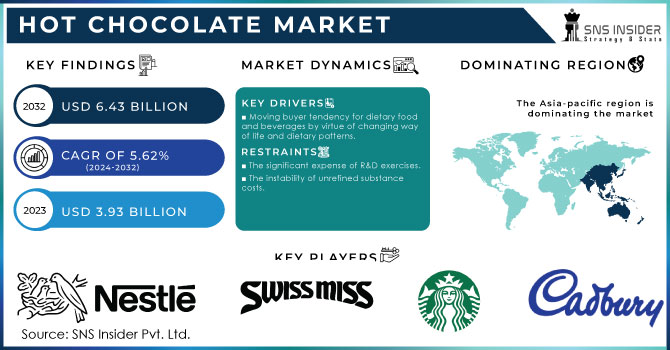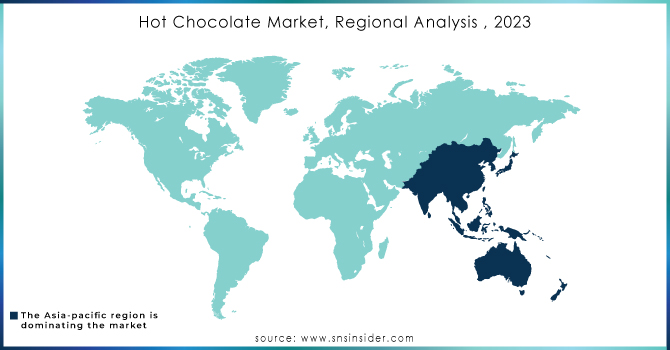Hot Chocolate Market Report Scope & Overview:

Get More Information on Hot Chocolate Market - Request Sample Report
The Hot Chocolate Market size was valued at USD 3.93 billion in 2023 and is expected to reach USD 6.43 billion by 2032 and grow at a CAGR of 5.62% over the forecast period of 2024-2032.
Drinking chocolate is frequently alluded to as hot cocoa. Drinking Chocolate is rich and smooth with a profound cocoa flavor. In specific nations, chocolate is alluded to as chocolate tea. Drinking chocolate, comprised of little bits of chocolate, which are gradually liquefied and blended in with milk and water, is eaten as a supper. It comprises of liquid chocolate, hot cocoa, chocolate powder, or cocoa powder.
Developing wellbeing mindfulness among customers in metropolitan families has prompted the expansion in the utilization of beverages, including hot cocoa. In addition, moving shoppers tendency toward healthful food varieties and beverages because of changing way of life and dietary patterns is supposed to drive the interest for hot cocoa in the impending years.
Cocoa is viewed as a critical fixing in the assembling of hot cocoa that has no substitute in the market attributable to which the makers progressively depend on these countries for their inventory. Unsettling influences and unpredictable stock prompts instability in the costs of cocoa on the lookout, accordingly hampering the development of hot cocoa market.
Market Dynamics:
Driving Factors:
-
Moving buyer tendency for dietary food and beverages by virtue of changing way of life and dietary patterns.
-
Expanding commonality and reliance of age X, recent college grads, and age Z guardians on online business.
Restraining Factors:
-
The significant expense of R&D exercises.
-
The instability of unrefined substance costs.
Opportunities:
-
The simplicity of installment for items through internet-based channels.
-
Drinking chocolate is progressively being utilized in the detailing of refreshments and dessert shop items.
Challenges:
-
Because of the soggy and warm environment of the planet, the market for cocoa is confronting a significant test.
-
Absence of admittance to back and lacking foundation.
Impact of Covid-19:
The chocolate market was hampered by low deals volumes brought about by the COVID-19 scourge, as well as supply-side worries connecting with quality and affirmation. Regarding trades, the Fine Cacao and Chocolate Institute (FCCI) overviewed the effect of the COVID-19 pandemic, which yielded a few upsetting outcomes.
As indicated by reports in the Dominican Republic, the radical lockdown forced kept makers and rural specialists from going to the estates for a considerable length of time until the specialists allowed exemptions. Along these lines, disturbance in the natural substance production network, trailed by lockdown, is bringing about a rising number of specialty stores staying shut for a drawn-out timeframe, and diminished volume utilization of premium chocolates.
Market Estimation:
The Hot chocolate market is divided based on type, cocoa content, application, flavor, structure, target customers, bundling type, bundling material, end-client and appropriation channel. The development among these portions will assist you with breaking down pitiful development sections in the businesses and give the clients a significant market outline and market bits of knowledge to assist them with settling on essential choices for distinguishing center market applications.
Key Market Segments:
By type:
-
Dark
-
White
-
Milk
By Distribution Channel:
-
Supermarkets
-
Hypermarkets
-
E-Commerce
-
Retail Store
-
Online Retail
-
Other
By cocoa content:
-
30%-40%
-
40%-60%
-
60%-90%
By Application:
-
Chocolate Drinks
-
Protein Shakes
-
Energy Drinks
-
Coffee Mixes
-
Others
By Flavour:
-
Vanilla
-
Caramel
-
Honey
-
Hazelnut
By Form:
-
Powder
-
Liquid
By Target customers
-
Adults
-
Kids
By End-users:
-
Food Service Providers
-
Household/Domestic
-
Corporates
-
Airlines
Regional Analysis:
North America
- USA
- Canada
- Mexico
- Europe
- Germany
- UK
- France
- Italy
- Spain
- The Netherlands
- Rest of Europe
Asia-pacific
- Japan
- South Korea
- China
- India
- Australia
- Rest of Asia-pacific
The middle east & Africa
- Israel
- UAE
- South Africa
- Rest of middle east & Africa
Latin America
- Brazil
- Argentina
- Rest of Latin America
Worldwide and country investigations are a portion of the primary measurements used to foresee homegrown market situations. It considers the presence and accessibility of worldwide brands, the issue areas of strength for of little contest with nearby and homegrown brands, and the effect of public duties and shipping lanes on country information projections.

Need any customization research on Hot Chocolate Market - Enquiry Now
Key Players:
Major players included in Hot chocolate Market are Nestle, Starbucks, Swiss Miss, The Hershey Company, W.T.Lynch Foods, GODIVA Chocolatier, Cadbury, Land O'Lakes, Chocomize, Chek Hup Sdn. Bhd.
| Report Attributes | Details |
|---|---|
| Market Size in 2023 | US$ 3.93 Billion |
| Market Size by 2032 | US$ 6.43 Billion |
| CAGR | CAGR 5.62% From 2024 to 2032 |
| Base Year | 2023 |
| Forecast Period | 2024-2032 |
| Historical Data | 2020-2022 |
| Report Scope & Coverage | Market Size, Segments Analysis, Competitive Landscape, Regional Analysis, DROC & SWOT Analysis, Forecast Outlook |
| Key Segments | • by type (dark, white, milk) • by Distribution Channel (Supermarkets, Hypermarkets, E-commerce, Other) |
| Regional Analysis/Coverage | North America (USA, Canada, Mexico), Europe (Germany, UK, France, Italy, Spain, Netherlands, Rest of Europe), Asia-Pacific (Japan, South Korea, China, India, Australia, Rest of Asia-Pacific), The Middle East & Africa (Israel, UAE, South Africa, Rest of Middle East & Africa), Latin America (Brazil, Argentina, Rest of Latin America) |
| Company Profiles | Nestle, Starbucks, Swiss Miss, The Hershey Company, W.T.Lynch Foods, GODIVA Chocolatier, Cadbury, Land O'Lakes, Chocomize, Chek Hup Sdn. Bhd. |
| Key Drivers | •Moving buyer tendency for dietary food and beverages by virtue of changing way of life and dietary patterns. |
| Restraints | •The significant expense of R&D exercises. •The instability of unrefined substance costs. |

